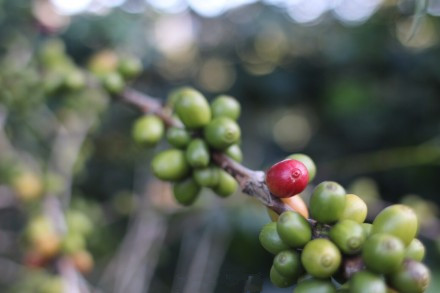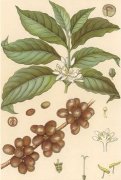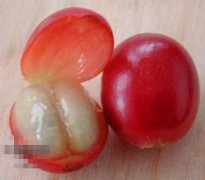The Leaf of Coffee and the growth process of Coffee Flower
Coffee leaves opposite, usually two rows spreading, individual single leaf whorl, petiole short, leaf leathery, green (dark green on the upper surface, light green on the lower surface). Glossy oval, oval to long oval. The leaf size of small-grain coffee is relatively uniform, the leaf is small and the end is longer, and the leaf edge wave is obvious, about 12-16 cm long and 5-7 cm wide. The leaves of the mid-grain species are long and large, soft and thin, with obvious ripples, about 20 cm long and 8 cm wide. The large-grained leaf blade is leathery, hard and thick, tip-pointed, and the leaf margin is nearly corrugated, about 17-20 cm long and 6-8 cm wide. The leaves of coffee trees are typically ventral and dorsal symmetrical. The leaves contain tannins, starch grains and calcium oxalate.

Several to dozens of flowers are clustered in leaf axils, and 2-5 flowers per month are planted on a flower axis, pedicels are short, flowers are white, petals of medium / small seeds are generally 5, and 7-8 of large-grained species, petals are connected at the base of the petals to form a high-footed butterfly-shaped Corolla, stamens are generally the same number as petals, inserted in the Corolla throat. Anthers two-loculed at the top of filaments, both forming a "D" shape, pistil style filiform, stigma bifid, ovary inferior, usually two-loculed, also one-loculed or triloculed. There is an anatropous ovule on the central placenta of each locule, the stalk is very short, insect-pollinated flowers, large and small seeds can be self-pollinated, and most of the medium-grain species are cross-pollinated.
1. Characteristics of flower bud development
Flower bud development: the formation of coffee flower bud is closely related to varieties and environmental conditions. Franco was the first to point out and confirmed by Piringer et al that coffee (except perennial flowering mutation) is a short-day plant. Under the condition of artificial light at night when the sunshine is more than 13 hours, the plant only grows vegetatively. Mes found that temperature can affect the budding of coffee. When the day temperature is 23 degrees Celsius and the night temperature is 17 degrees Celsius, the flower buds produced by the plant are more than the day temperature 26 degrees Celsius, the night temperature 20 degrees Celsius, the day and night temperature 30 degrees Celsius, the night temperature 22 degrees Celsius, the flower buds are underdeveloped. Under sufficient sunlight, most of the axillary buds of annual branches of medium-grain coffee are sterile, or only a few flower buds develop, and blossom and bear fruit.
The axillary buds germinated in different periods of the same kind of coffee take different time to develop into flowers, such as medium-grain coffee, the axillary buds sprouted before May need the longest time (about 6-8 months), the axillary buds sprouted from May to October need medium time (about 4-5 months), and the axillary buds formed from October to November need the shortest time from beginning to flowering (3-4 months).
two。 Flowering characteristics
2.1 Coffee has the characteristics of multiple flowering, flowering and florescence concentration. the flower buds of coffee are compound buds, and there are 2-6 flower buds in each leaf axilla. at the same time, the germination of one leaf axillary bud (or different plant flower buds) is inconsistent, first and later, forming the phenomenon of multiple flowering, but there is a relative middle stage of flowering every year, that is, the full flowering period. the flowering period of coffee varies with different species and environmental conditions. The florescence of small seed coffee in Hainan Island is from November to April, and the flowering period is from February to April. In Yunnan (Dehong Dai Jingpo Autonomous Prefecture), the florescence is from February to July, the full bloom is from March to May, and in Guangxi, the florescence is from February to June and from April to June.
2.2 the flowering of coffee is greatly affected by climate, especially rainfall and air temperature. it takes a certain amount of water to develop flower buds to separate buds / flowering. High temperature and drought, small seed coffee bud development is normal, forming "star flower" / "melon flower". Excessive drought, coffee buds are small, do not bloom or do not bear fruit after flowering. The flower buds do not open when the temperature is below 10 degrees Celsius, but the temperature above 13 degrees Celsius is conducive to flowering.
The life span of coffee flowers is short, only 2-3 days. Small coffee flowers usually bloom at 3: 5 a.m. and bloom at 5-7 a.m., and the stamen anthers release a small amount of pollen before they bloom. At about 9-10:00, the pollen sac cleaves and releases a large amount of pollen. Medium-grained species have more pollen than small-grained ones. The style and stamens of different kinds of coffee matured sooner or later, and the stigma of small species matured earlier than stamens. The ability of stigma pollination was the strongest on the day of flowering and the next day, and then gradually lost its pollination ability, and the petals withered quickly. In the case of drought / wind or cold current at the flowering stage, the style is vulnerable to drying up, and if it rains continuously, the Corolla is easy to rot, which affects pollination / fertility and yield.
Important Notice :
前街咖啡 FrontStreet Coffee has moved to new addredd:
FrontStreet Coffee Address: 315,Donghua East Road,GuangZhou
Tel:020 38364473
- Prev

The growth of coffee trees the process of growing coffee beans
The growth and fruit of coffee trees varies with different varieties / environmental conditions. In the high altitude area of Yunnan, the small seed coffee cultivated has the advantages of cold climate, large cloud cover, short light and slow plant growth, but the branches develop into sturdy backbone branches after the first branch bears fruit, and the second / third branch has strong ability to produce. The growth is exuberant and the fruit is dense, which is the main fruiting branch, so it is suitable to adopt single trunk shaping. Two / three
- Next

Basic knowledge of fine coffee knowledge of coffee fruit
The fruit is a berry, also known as comb fruit. Oval, 9-14 mm long, young fruit green, red at maturity, purplish red. Each fruit generally has two seeds, but also one or three, showing a semi-oval, there is a longitudinal groove, called grooves. The structure of a fruit in which the exocarp consists of a thin layer of hardwood human cells with stomata; the mesocarp (that is, pulp) is large and Lignified by several layers of polygons.
Related
- Beginners will see the "Coffee pull flower" guide!
- What is the difference between ice blog purified milk and ordinary milk coffee?
- Why is the Philippines the largest producer of crops in Liberia?
- For coffee extraction, should the fine powder be retained?
- How does extracted espresso fill pressed powder? How much strength does it take to press the powder?
- How to make jasmine cold extract coffee? Is the jasmine + latte good?
- Will this little toy really make the coffee taste better? How does Lily Drip affect coffee extraction?
- Will the action of slapping the filter cup also affect coffee extraction?
- What's the difference between powder-to-water ratio and powder-to-liquid ratio?
- What is the Ethiopian local species? What does it have to do with Heirloom native species?

